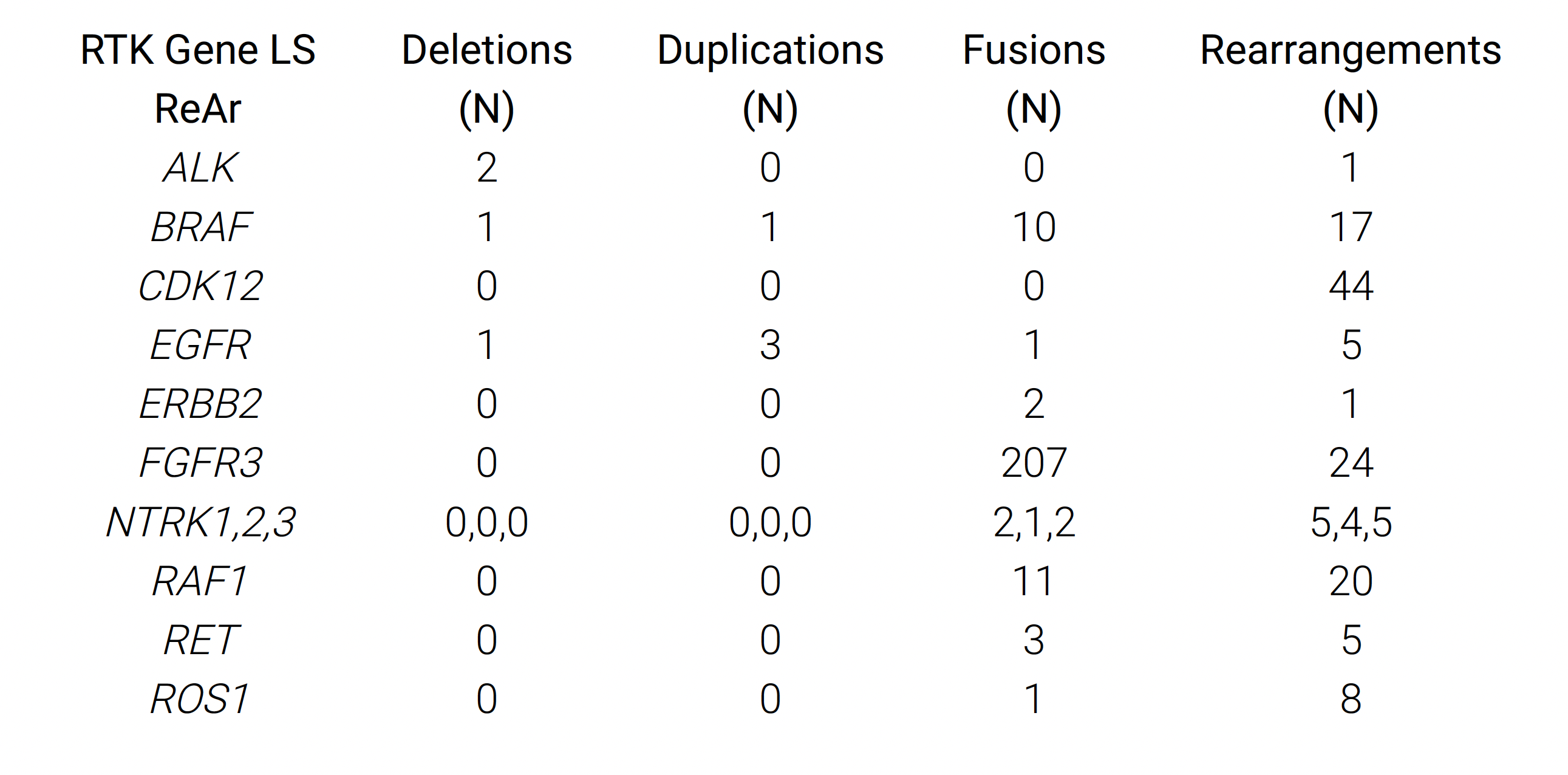Back
Poster, Podium & Video Sessions
Podium
PD42: Bladder Cancer: Invasive IV
PD42-05: Expanding the use of targeted therapy for urothelial bladder cancer (UBC): Non-FGFR3 receptor tyrosine kinase (RTK) gene rearrangements (ReAr) and fusions (fus)
Sunday, May 15, 2022
10:10 AM – 10:20 AM
Location: Room 245
Andrea Necchi*, Milan, Italy, Dean Pavlick, Cambridge, MA, Gennady Bratslavsky, Joseph Jacob, Oleksandr Kravtsov, New York, NY, Philippe Spiess, Tampa, FL, Petros Grivas, Seattle, WA, Vamsi Parini, Brennan Decker, Lin Douglas, Danziger Natalie, Levy Mia Alyce, Jeffrey Ross, Cambridge, MA
- KR
Kyle M. Rose, MD,MS
Moffitt Cancer Center
Podium Presenter(s)
Introduction: After the regulatory approval of erdafitinib targeting FGFR genomic alterations (GA), molecular profiling and targeted therapy indications may further expand in UBC. We queried a large database of advanced UBC to study the landscape of RTK ReAr and Fus to categorize additional targets beyond FGFR1-3 that have potential to further personalize treatment of this disease.
Methods: We analyzed data from 8,233 UBC cases, which underwent hybrid capture-based comprehensive genomic profiling (CGP). Tumor mutational burden (TMB) was determined on up to 1.1 Mbp of sequenced DNA and microsatellite instability (MSI) was determined on 114 loci. PD-L1 expression in tumor cells was assessed by IHC (Dako 22C3).
Results: A total of 1,210 (14.7%) UBC featured known and likely large-scale (LS) internal ReAr with 414 (5%) ReAr in RTK genes. The ReAr/fus were distributed among ABL1 (3), ALK (3), BRAF (29), CDK12 (44), CDK8 (1), EGFR (10), ERBB2 (3), FGFR1 (2), FGFR2 (16), FGFR3 (231), FLT3 (1), MAO2K4 (4), NTRK1 (7), NTRK2 (5), NTRK3 (7), RAF1 (31), RET (8) and ROS1 (9). LS ReAr were divided into LS ReAr-associated gene deletions (1%), truncations (1%), rearrangements (61%) and fusions (37%). FGFR3 fus accounted for 81% of RTK fus with BRAF and RAF1 both at 2%. The greatest frequencies of kinase ReAr were in CDK12 (29%), FGFR3 (16%), RAF1 (13%) and BRAF (12%). Additional noteworthy ‘targetable’ RTK ReAR and fus included NTRK1-3 (19 cases), ROS1 (9 cases), RET (8 cases) and ALK (1 case). 407 (98.4%) of the RTK ReAr/fus-positive UBC had only 1 RTK ReAr/fus GA and 7 (1.6%) had 2 ReAr ReAr/fus, 6 (85.7%) of which involved FGFR3. Compared with LS ReAR negative UBC, the LS ReAR UBC cases revealed similar gender and age characteristics, MSI status, similar frequencies of TMB = 10 mut/Mb and PD-L1 expression in tumor cells =1% and =50%.
Conclusions: At a 5% frequency, potentially ‘targetable’ RTK gene rearrangements and fusions are a rare but important opportunity to further personalize treatment selection of UBC, including RTK inhibitors, PARP inhibitors (CDK12) and immunotherapy. This potential for clinical trials supports broader CGP, compared to targeted FGFR sequencing, in order to uncover additional opportunities for precision therapies that have the potential to improve patient outcomes.
Source of Funding: Foundation Medicine

Methods: We analyzed data from 8,233 UBC cases, which underwent hybrid capture-based comprehensive genomic profiling (CGP). Tumor mutational burden (TMB) was determined on up to 1.1 Mbp of sequenced DNA and microsatellite instability (MSI) was determined on 114 loci. PD-L1 expression in tumor cells was assessed by IHC (Dako 22C3).
Results: A total of 1,210 (14.7%) UBC featured known and likely large-scale (LS) internal ReAr with 414 (5%) ReAr in RTK genes. The ReAr/fus were distributed among ABL1 (3), ALK (3), BRAF (29), CDK12 (44), CDK8 (1), EGFR (10), ERBB2 (3), FGFR1 (2), FGFR2 (16), FGFR3 (231), FLT3 (1), MAO2K4 (4), NTRK1 (7), NTRK2 (5), NTRK3 (7), RAF1 (31), RET (8) and ROS1 (9). LS ReAr were divided into LS ReAr-associated gene deletions (1%), truncations (1%), rearrangements (61%) and fusions (37%). FGFR3 fus accounted for 81% of RTK fus with BRAF and RAF1 both at 2%. The greatest frequencies of kinase ReAr were in CDK12 (29%), FGFR3 (16%), RAF1 (13%) and BRAF (12%). Additional noteworthy ‘targetable’ RTK ReAR and fus included NTRK1-3 (19 cases), ROS1 (9 cases), RET (8 cases) and ALK (1 case). 407 (98.4%) of the RTK ReAr/fus-positive UBC had only 1 RTK ReAr/fus GA and 7 (1.6%) had 2 ReAr ReAr/fus, 6 (85.7%) of which involved FGFR3. Compared with LS ReAR negative UBC, the LS ReAR UBC cases revealed similar gender and age characteristics, MSI status, similar frequencies of TMB = 10 mut/Mb and PD-L1 expression in tumor cells =1% and =50%.
Conclusions: At a 5% frequency, potentially ‘targetable’ RTK gene rearrangements and fusions are a rare but important opportunity to further personalize treatment selection of UBC, including RTK inhibitors, PARP inhibitors (CDK12) and immunotherapy. This potential for clinical trials supports broader CGP, compared to targeted FGFR sequencing, in order to uncover additional opportunities for precision therapies that have the potential to improve patient outcomes.
Source of Funding: Foundation Medicine


.jpg)
.jpg)